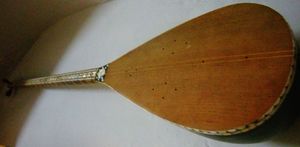Uzbek plucked string instruments
Uzbek plucked string instruments
-The rubob : This is the most common plucked string instrument in Uzbekistan. One can also find it in the Kirghiz![]() Fergana valley and in the Xinjiang Chinese province (where I am right now) under the name of “rawab”. One can easily recognize it thanks you its two horn shaped woods at the bottom of its neck and its table made of animal skin. Fish skin is very commonly used but one can also find cow skin (or snake skin in Xinjiang). It has a quite small body made of mulberry tree wood most of the time. The neck is traditionally decorated with camel bones or seashell nacre incrustations. One usually plays it with a pick and has to fit the body under his shoulder and hold the neck with the other hand which allows for a stand up position while playing.
Fergana valley and in the Xinjiang Chinese province (where I am right now) under the name of “rawab”. One can easily recognize it thanks you its two horn shaped woods at the bottom of its neck and its table made of animal skin. Fish skin is very commonly used but one can also find cow skin (or snake skin in Xinjiang). It has a quite small body made of mulberry tree wood most of the time. The neck is traditionally decorated with camel bones or seashell nacre incrustations. One usually plays it with a pick and has to fit the body under his shoulder and hold the neck with the other hand which allows for a stand up position while playing.
-The Afghan rubob: It looks like the normal rubob but has much a bigger oval shaped body. Its strings are made of![]() nylon or silk. A part of the table is made of wood, the other part is made of animal skin.
nylon or silk. A part of the table is made of wood, the other part is made of animal skin.
The tambur : The origin of everything ? It might be. It is a very ancient Persian plucked string instrument, the ancestor of the luth which has spread all over the Eurasian continent over the centuries thank to cultural exchanges or invasions. One can find many different versions of it (for example the Croatian tambura is one of them). The Uzbek version has an oval body with a few little holes on the table. It is played with a special kind of pick that one fits on his index finger before playing.
ancestor of the luth which has spread all over the Eurasian continent over the centuries thank to cultural exchanges or invasions. One can find many different versions of it (for example the Croatian tambura is one of them). The Uzbek version has an oval body with a few little holes on the table. It is played with a special kind of pick that one fits on his index finger before playing.
-The dotar : It is a Persian word which means « two strings ». It is an instrument coming from the tambur that is very usually found in Central Asia with different neck lengths. Its name talks by itself: it has two strings, and one plays it without any pick. As a guitar player, this is the local instrument with which I am the most comfortable. One can make it sound quite similarly to a guitar and its touch is very nice.
usually found in Central Asia with different neck lengths. Its name talks by itself: it has two strings, and one plays it without any pick. As a guitar player, this is the local instrument with which I am the most comfortable. One can make it sound quite similarly to a guitar and its touch is very nice.
-The tar : I mentioned it when I wrote my crossing of Turkey. It comes from Azerbaijan and western Iran (in Tabriz province). As you may have deduced: “Tar” means “string” in Persian. It has a 8-shaped body made of mulberry tree wood and covered with animal skin. It sounds a bit similar to a rubob but it is slightly more slamming, less soft…
province). As you may have deduced: “Tar” means “string” in Persian. It has a 8-shaped body made of mulberry tree wood and covered with animal skin. It sounds a bit similar to a rubob but it is slightly more slamming, less soft…
In general, one can find many similarities in the musical instruments of all the countries and ancient Turkestan in which people speak Turkish based languages including: Turkey, Azerbaijan, Turkmenistan, Uzbekistan, Kirghizstan, Kazakhstan, Chinese province of Xinjiang, Western Iran etc… This entire region was part of the Persian Empire long time ago. Therefore these people have a common base which has evolved in their own style with many similarities and differences which are interesting to discover.
Other Uzbek instruments: the Ney is an oriental flute, the Doira is a local tambourine and the Santur is a struck string instrument.

/https%3A%2F%2Fstorage.canalblog.com%2F64%2F66%2F859057%2F81096555_o.jpg)
/https%3A%2F%2Fstorage.canalblog.com%2F22%2F23%2F859057%2F80680603_o.jpg)
/https%3A%2F%2Fstorage.canalblog.com%2F44%2F78%2F859057%2F80680222_o.jpg)
/https%3A%2F%2Fstorage.canalblog.com%2F36%2F15%2F859057%2F79960983_o.jpg)
/https%3A%2F%2Fstorage.canalblog.com%2F38%2F20%2F859057%2F79473547_o.jpg)


/http%3A%2F%2Fstorage.canalblog.com%2F86%2F62%2F859057%2F70381986_o.jpg)
/http%3A%2F%2Fstorage.canalblog.com%2F78%2F11%2F859057%2F70381763_o.jpg)
/https%3A%2F%2Fassets.over-blog.com%2Ft%2Fcedistic%2Fcamera.png)
/http%3A%2F%2Fstorage.canalblog.com%2F28%2F71%2F859057%2F71610951_o.jpg)